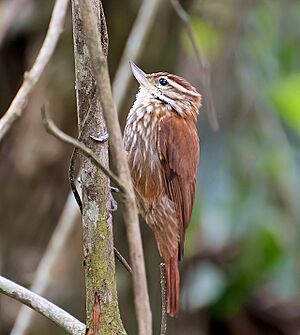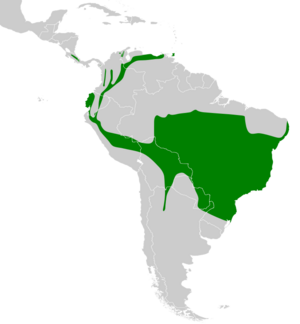Streaked xenops facts for kids
Quick facts for kids Streaked xenops |
|
|---|---|
 |
|
| In Piraju, São Paulo, Brazil | |
| Conservation status | |
| Scientific classification | |
| Genus: |
Xenops
|
| Species: |
rutilans
|
 |
|
| Synonyms | |
|
Xenops rutilus |
|
The streaked xenops (Xenops rutilans) is a small passerine bird, which means it's a type of songbird. It belongs to the ovenbird family called Furnariidae. You can find this bird in the New World (the Americas), from Costa Rica and Trinidad in the north, all the way south to Bolivia and Argentina.
Contents
About the Streaked Xenops
What Does a Streaked Xenops Look Like?
The streaked xenops is about 12 to 13 centimeters (5 inches) long. It weighs between 10 and 15 grams, which is about as much as two quarters. Its beak is short, thick, and shaped like a wedge. Male and female streaked xenops birds look very similar.
The most common type, called X. r. rutilans, has some special features. It has a clear, light yellow stripe above its eye and a white stripe on its cheek. Its face is brownish. The top of its head is dark brown with reddish-brown streaks. Its back is reddish-brown with faint lighter streaks. The rump (lower back) and tail feathers are a plain reddish-chestnut color. The tail itself is also reddish-chestnut, but one pair of feathers has a blackish inner part.
Its wing feathers are dark and have a reddish tint on the outer edges. The bird's throat and upper chest are whitish with darker spots. The rest of its belly has wide, light yellowish-white streaks with dark brownish edges on a medium brownish background. These streaks become narrower and lighter on the lower belly. The bird's eyes are brown, its upper beak is dark brown to black, and its lower beak is whitish to pinkish-gray with a black tip. Its legs and feet are gray to black. Young streaked xenops birds have less clear streaks and less black on their tails.
Where Do Streaked Xenops Live?
The streaked xenops lives in many different places across the Americas. There are 11 different types, or subspecies, of this bird, and each lives in a specific area.
- Some live in Costa Rica and western Panama.
- Others are found in Trinidad, northern Venezuela, and the Andes mountains in Colombia and Ecuador.
- You can also find them in parts of Peru, Bolivia, Paraguay, and Argentina.
- Many live in different regions of Brazil.
In mountains, the streaked xenops lives in evergreen and deciduous forests. They usually live at heights between 700 and 2400 meters (about 2,300 to 7,900 feet) above sea level. In lower areas, they live in many kinds of forests and woodlands. These can be dry or humid, including tropical forests that have never been cut down and forests that are growing back. They like to stay inside the forest or at its edges.
Streaked Xenops Behavior
Movement and Home
The streaked xenops stays in the same area all year round. It does not migrate to different places.
What Do Streaked Xenops Eat?
Streaked xenops birds mainly eat arthropods, which are creatures like insects and spiders. They have been seen eating the larvae (young forms) of wood-boring beetles. They also eat adult insects.
These birds often join groups of different bird species that are looking for food together. They search for food in the lower parts of the forest, at the edges, and higher up in the middle and upper parts of the trees. They are very good at climbing along thin branches. They sometimes use their tail to help them balance. They find their food by picking it off surfaces, chiseling into wood, and flaking off bark. They have even been seen catching flying termites in the air!
Reproduction and Life Cycle
Scientists don't know much about the breeding season for streaked xenops in most areas. However, in Costa Rica, they breed from January to May. On the island of Trinidad, they breed from February to May.
The streaked xenops builds its nest in a hole. This hole might be natural, made by a small woodpecker, or even dug by the xenops itself. They add a small amount of soft plant material to the bottom of the nest. Nests have been found from 1.5 to 9 meters (about 5 to 30 feet) above the ground. A female streaked xenops usually lays two or three eggs. We don't know how long the eggs take to hatch or how long it takes for the young birds to leave the nest. We also don't know much about how the parents care for their young.
What Sounds Do Streaked Xenops Make?
The song of the streaked xenops is a series of 5 to 10 high-pitched, dry, squeaky notes. It starts low, goes up, and then comes back down, getting faster at the end. It sounds like "swee" or "zeet". Their calls are a high, sharp "peet" or "cheet".
Streaked Xenops Conservation Status
The IUCN (International Union for Conservation of Nature) has listed the streaked xenops as a species of "Least Concern". This means they are not currently in danger of disappearing. They live across a very large area, and their population is estimated to be at least five million adult birds. This number is believed to be stable, meaning it's not going down.
No immediate threats to the streaked xenops have been found. They are considered uncommon to fairly common in most places where they live. They are also found in many protected areas, which helps keep them safe. The streaked xenops seems to handle changes to its habitat fairly well. It can even survive in small, damaged forest areas, though sometimes with fewer birds.


